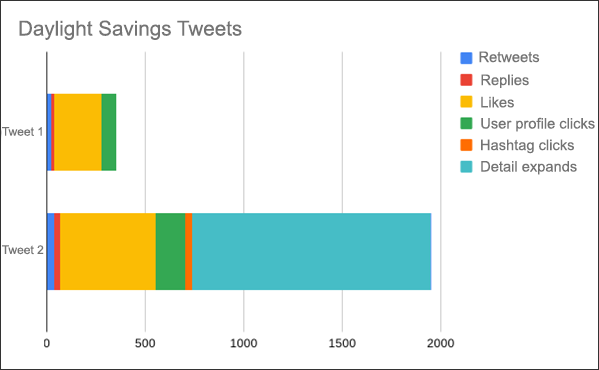Social Media Data Analysis and Reporting
Para la versión en español, de click aquí.
In this analysis, I will be using information from the Grow With Google Digital Marketing and e-Commerce course, not this website. The course provides me with the data and tools I need to create the necessary information to showcase my acquired knowledge in digital marketing and e-commerce.
You can view the data here.
| Task | Response |
| Compare the Tweets’ data. | Tweet 1 had 1.9x the impressions of Tweet 2, but Tweet 2 received 5.8x the engagements. Tweet 2 performed better overall. This is because Tweet 2 received more engagements, which was the goal of the campaigns. |
| Compare the Tweets’ content and details. | Tweet 1 had no images or hashtags, was posted at 8:03 AM on 3/13, and received fewer engagements than Tweet 2, which included an image and two hashtags, was posted at 1:59 AM on 3/14, and had more engagements. The text of Tweet 2 is funnier and more engaging than the text of Tweet 1. Tweet 2 performed better than Tweet 1 because it had more of the elements that are known to increase engagement: an image, two hashtags, and a funnier and more engaging text. |
| Analyze the differences in the Tweets’ performance. | Tweet 1 was posted at 8:03 AM, which is a peak time for Twitter traffic. This means that it was seen by more people than Tweet 2, which was posted at 1:59 AM, a time when fewer people are typically online. However, Tweet 2 performed better than Tweet 1 because it included a humorous image and text, as well as relevant hashtags. These elements made Tweet 2 more engaging and likely to be retweeted and liked. |
| Explain how your analysis will inform your strategy. | The data shows that our audience on Twitter prefers content that is funny, engaging, and visually appealing. This means that I will incorporate more humor into my future tweets, as well as use relevant hashtags and images. For greater success in future tweets, we will procure using humor, images and appropriate hashtags, this way, we will get more engagement from our audience. |
Social media data analysis is the process of collecting and analyzing data from social media platforms to gain insights into the audience, track the performance of marketing campaigns, and optimize strategies. This data can be used to understand what the audience is interested in, what kind of content they engage with, and how they interact with the brand. By analyzing this data, anyone can identify trends, improve their targeting, and create more effective marketing campaigns.
Reporting
Properly reporting the progress and/or results of a social media campaign is essential for social media marketing. This allows team members and stakeholders to understand the value the campaign brought to the brand.
The following report provides an informative overview of the analysis:
This is an update on the performance of the two tweets we published around daylight saving time. The goal of this campaign was to increase audience engagement, so we tracked key performance indicators (KPIs) such as retweets, replies, and likes.
Here are the key takeaways from our analysis of the two tweets:
- Tweet 1 was viewed nearly twice as many times as Tweet 2. This is likely because Tweet 1 was posted at 8:03 am, when more people are likely to be online, while Tweet 2 was posted at 1:59 am, right before the time change, when fewer people are likely to be online.
- Despite being viewed far less, Tweet 2 had nearly six times as many engagements as Tweet 1. This is likely because Tweet 2 contained a funny image, relevant hashtags, and text that users found more engaging. Tweet 1 did not contain any images or hashtags.
We will include images, hashtags, and humor in our future tweets to increase engagement with our audience on Twitter. I’m happy to discuss this further if you have any questions. Please don’t hesitate to reach out.
Analyzing social media data can help you understand your audience, competitors, and what content works best on each platform. This information can be used to improve your social media strategy and make better decisions about your content creation and promotion.
